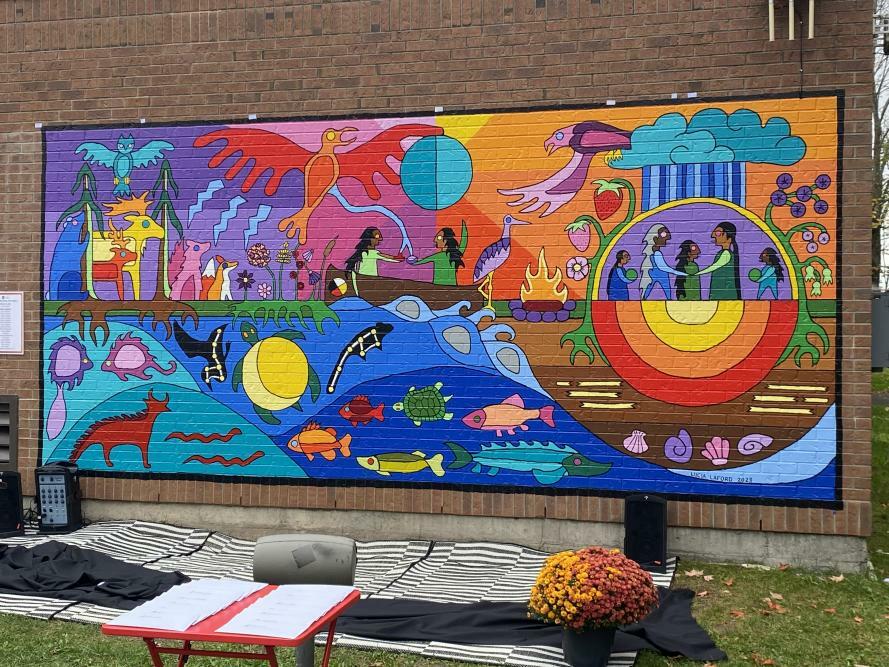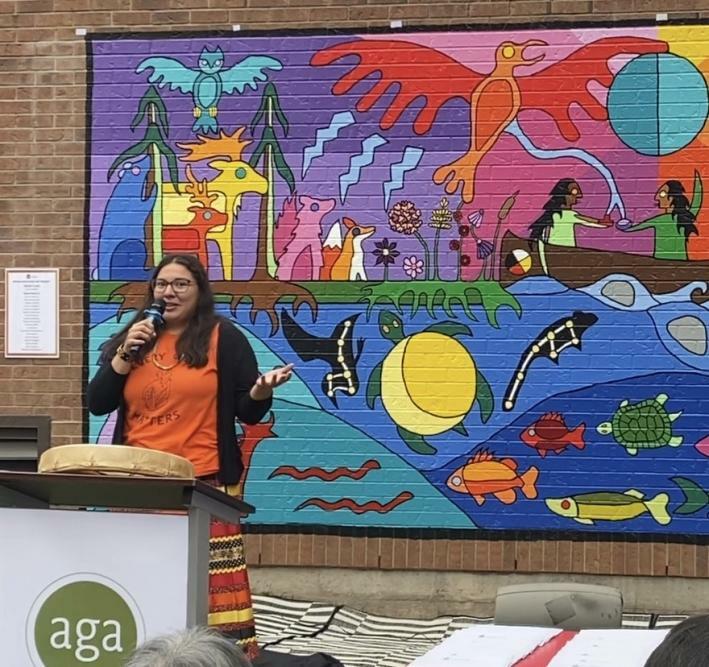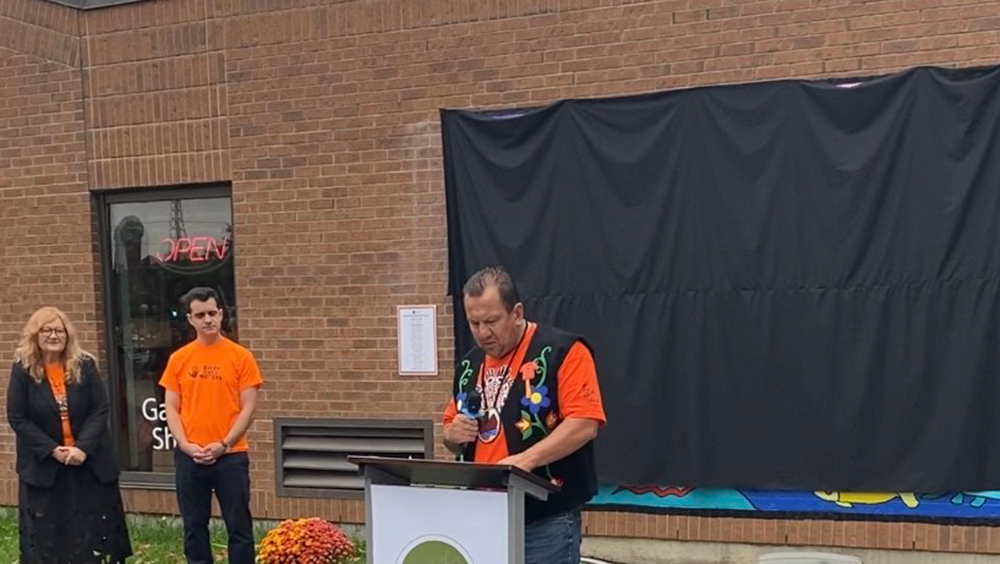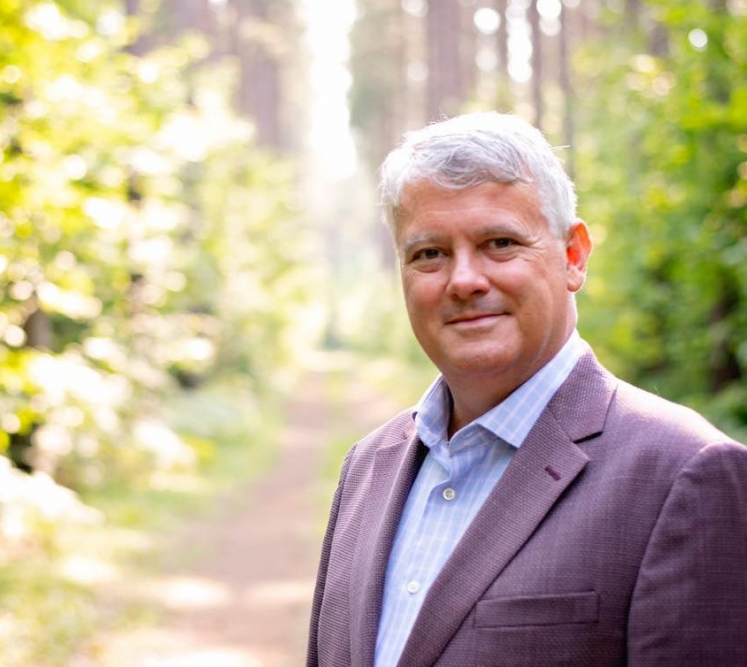Lucia Laford’s Aboriginal Woodland Art Mural was unveiled Saturday afternoon, a beacon of colorful light on an otherwise dull early autumn day.
Dignitaries on hand included Sault Mayor Matthew Shoemaker, Sault MPP Ross Romano, Batchawana First Nation Chief Mark McCoy, and retired Senator, the Honourable Patricia Bovey. Shortly after 1 p.m., Indigenous artist Laford and Sault Mayor Shoemaker dropped the black cloth to officially unveil the striking mural, at its home on the west front wall of the Art Gallery of Algoma, to a hearty round of
applause.

Laford told the gathering she was blessed to work with a “beautiful group of youths” through the summer, aged 12 to 20. In workshops, she taught them about murals, woodland-style art, what it means to be an artist and one that is engaged in the community. She taught them about the symbolism of Woodland art and its importance to the Algoma area. Then, the project’s physical work began in earnest.
“I made them scrub the wall, there was a lot of moss, they scrubbed it diligently. After they scrubbed it, they helped me prime it. They helped me through every, single step,” Laford explained.
Saturday’s unveiling coincided with Canada’s National Day for Truth and Reconciliation, also known as Orange Shirt Day, a day for the country to pause and reflect on the horrors put upon indigenous children across the nation at many residential schools. Orange shirts are worn to honour survivors of the atrocities at residential schools and many in the crowd wore orange at Saturday’s unveiling.
Calling the mural one step of many necessary steps toward reconciliation, Mayor Shoemaker told the gathering the City recognizes “the ongoing trauma” caused by residential schools. “Education is the foundation to understanding our role as Canadians, our role as municipal government, and our role in reconciliation with our neighbours,” said Shoemaker.
“The mural we are here to celebrate today, is a tremendous example of what’s possible, when reconciliation and collaboration inform our actions, continued Shoemaker. “Residential schools separated indigenous children from their families in order to minimize and weaken family ties and cultural
linkages and to indoctrinate children into a new culture, initiatives such as this help make reconciliation a reality by preserving and promoting indigenous culture.”
Shoemaker says he believes the local community is committed to having mutually respectful relationships between indigenous and non-indigenous people.
Laford credited the mural’s imagery to her youth group. She asked them in the earliest stages what they’d like to see in it. The completed picture “tells a story” with a theme of protecting the water and protecting the land.

Indigenous and Woodland-style artist Lucia Laford addresses gathering at the Art Gallery of Algoma, Saturday.
While living in Toronto 10 years ago, Laford said she didn’t see much of herself reflected in the city “and that hurt,” adding a feeling of cultural exclusion spurred her interest and efforts in woodland art.
With her own experiences in mind, she impressed upon the youth group helping her of the importance of being able to see a bit of yourself reflected in the city in which you live, and stressed to her group that they can have their own voice, become artists themselves, and be heard.
Batchawana First Nation Chief McCoy noted the cooperative efforts of the Batchawana First Nation, the Indian Friendship Centre, the City of Sault Ste. Marie and the Art Gallery of Algoma that helped make the project happen. He said Batchawana First Nation was thrilled to participate “because every child does matter. “Our leadership has always encouraged the meaningful discussions about the effects of residential schools and the legacy they left behind,” said Chief McCoy. “Please take some time today to put down some tobacco and reflect on the important journey our ancestors have overcome to allow each of us to be here today. The day is one that fosters respect and mutual understanding to honor the legacy of the survivors and those that did not make it home.”
Sault MPP Ross Romano said it’s important to recognize the atrocities indigenous people endured over several decades. “When we talk about truth and reconciliation, that is the start, isn’t it?
Before we can get to reconciliation, we need to understand our history. We need to understand what led us here. Young people are starting to understand more. All people are starting to understand more. The
discoveries over the last several years, are leading us on a path to reconciliation, and that is a good thing.”
Attendee Carianne Robinson said the mural is “so cool.” A mother of two of the youth participants in the project, Robinson says Laford’s inclusive teaching style and welcoming approach to ideas are impressive.
“A lot of the art and culture that the children are learning through this is the story-telling and how important that is in the process of making the art,” said Robinson. “Yes, the techniques are important but the story and the culture behind what they’re trying to make…they spent several weeks just doing that and it was a very intense process for a lot of them.”






